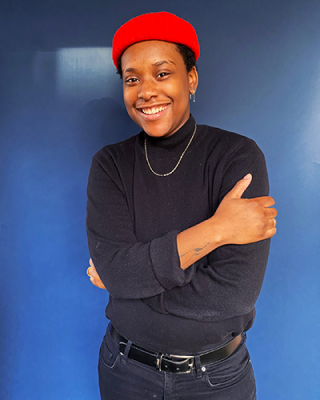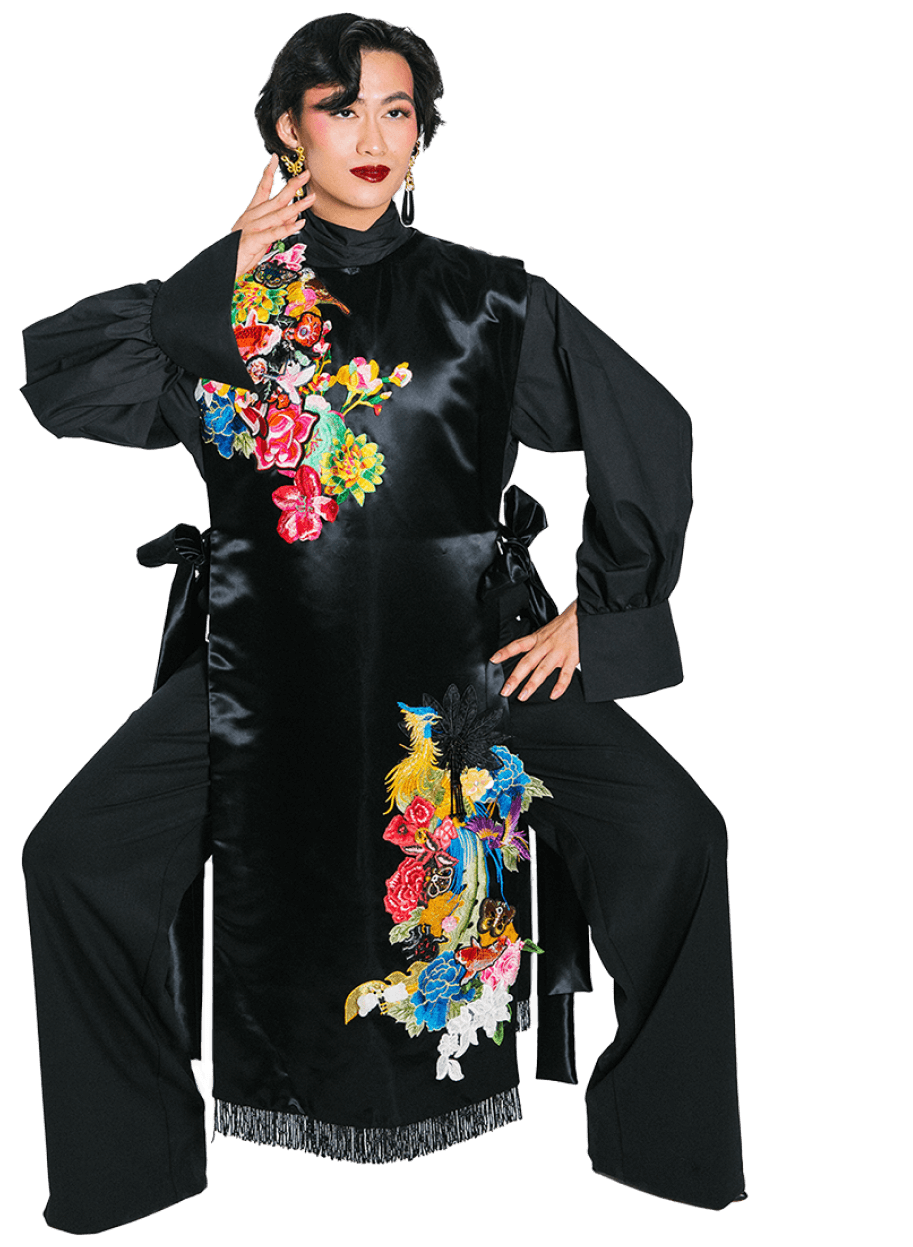THE BUSINESS OF GENDER-NONCONFORMING FASHION

Since fashion is a key component of self-expression, it’s no surprise that as the concept of gender evolved, so too would the search for garments that allow nonbinary and transgender people to present as their authentic selves. In fact, the State of Fashion 2023 report by the Business of Fashion and McKinsey shows that half of Gen Z worldwide have purchased clothing outside their gender identity.
The rise of gender-neutral and -nonconforming apparel has offered opportunities for designers. But it has also challenged the fashion industry to market these garments while navigating conservative voices decrying “woke” fashion. Five alumni discussed their entry into what is—for now—a niche market.
Designing in a Gendered World
“I believe everything can be for all genders. But everyone automatically thinks ‘gay’ when they think ‘gender-neutral,’” says Bentley Wederski, founder and CEO of Utilitarian, a high-end, menswear-inspired label based in Jackson Hole, Wyoming. “I was pigeonholed as an LGBTQ brand. I want to serve that community, but those folks were searching for Pride T-shirts, not $500 leather boots.”
Wederski, Fashion Business Management ’20, launched his company to go beyond “unisex gray hoodies … and into the idea that gender is just a structure society has made up.” So he created tailored garments with minimalist design: coordinating tops and bottoms, handbags, and a line of shoes and boots suitable for any gender.
Terence Bogan ’89, a Fashion Business Management faculty member and merchandising executive, says this is the ideal strategy for designers moving into gender-neutral fashion: to “have a strong point of view and balance within the selection, hitting all different ranges for your customer.” In other words, designers can’t offer only unisex T-shirts; like Wederski, they must provide a range of garments anyone can wear.

Bentley Wederski’s four principles for gender-neutral brands
1.
Eliminate concepts of “menswear” or “women’s wear” and instead consider fashion as self-expression.
2.
Embrace and showcase gender-neutral imagery by featuring androgynous models and models of both genders wearing identical outfits.
3.
Make messaging and descriptions inclusive by providing actual clothing measurements, not just gendered sizes.
4.
Rethink the categorization of products to allow for a range of sizes; his brand fits XS to XL. Wederski says that during a stint at Anthropologie, the company launched a plus-size line that did very well. He took those sales figures to his own investors.
Despite these outliers, the language around clothing is highly gendered, directing consumers to choose either men’s or women’s garments—e.g., shirts vs. blouses—as is the industry’s purchasing and marketing. “It struck me as odd that men’s base sizes were pattern graded in one way, and women’s in another. I threw that concept out the door,” Wederski says. “I worked with awesome patternmakers to tweak the design for all genders.”
Success Stories
Ironically, what makes gender-neutral clothing lines a success—considering every aspect, then fully designing the line through that lens, as Wederski did—also creates stumbling blocks.
“The biggest challenge is approaching department stores,” Bogan says. “It’s hard for them to figure out where it should be positioned,” or whether to send over a men’s or women’s buyer. Bogan advises designers to “present your collections as one capsule” so the line will resonate, citing as an example the Moose Knuckles x Telfar quilted pant and ballistic bomber jacket unisex marketing campaign.
“It is niche now, a small piece of the puzzle in the grand scheme,” he explains. “To succeed, you’d pair with a forward-thinking retailer who’d take a chance.”
Some designers cater to a niche market, while others, like the unisex jewelry brand Automic Gold, offer products anyone can wear.
“Jewelry is just jewelry; it doesn’t have to be gendered,” says Alexus Parker, Illustration ’17, creative director for Automic Gold, which offers 14K gold custom jewelry for both LGBTQ and straight couples at competitive prices and aligned with their aesthetic.
“Someone shouldn’t feel rejected or uncomfortable—especially when buying something that costs a lot of money,” Parker says. Automic Gold offers jewelry favored by the LGBTQ community, like nose rings, ear cuffs, and facial piercings.


Kris Harrington, Menswear ’14, bucked established trends around eveningwear—“tuxedoes for men and gowns for women”—and created tailored, non-gendered formal wear. “For far too long, the fashion industry has only catered to two different types of people, yet we live in a world where we’re seeing so many different representations.”
The Kris Harring Apparel Group line includes tailored tops, sheer trousers, vests, and blazers, plus a stylized caftan that can be customized by the wearer via draping. A Black queer designer, Harrington says fashion is activism. “Socially and legally, they’re trying to restrict how we express ourselves, who we’re able to be, so the work extends beyond fashion, as our lives are literally on the line.”

Meanwhile, Harrington says, fashion itself needs to evolve. Everything from concept to fabric selection tends to be gendered. And most gender-neutral garments are fitted on male models, which is a problem. “At a recent fitting, I noticed that no one else in the room was built like this model, yet we were making a huge run of clothes based on his body. We need to question how we create.”
So Harrington is moving away from using male models in favor of designing with Browzwear, 3D fashion software she says is both sustainable and cost-saving. While it’s nice that mainstream designers have joined the conversation, their participation so far has been “limited to T-shirts and hoodies, and nobody needs that. They are probably still designing gender-neutral garments on a men’s form.” Harrington adds that “true gender-neutral designers relish the opportunity to design clothes to fit all folks.”

For Becca McCharen-Tran, CEO and creative director of the “future-forward bodywear” brand Chromat and an alum of FIT’s Design Entrepreneurs program (now discontinued), “Garments are just objects, without gender. But the history of fashion has so many elements of control, dominance, and power, that it’s hard separating the two.
“Society must rid itself of homophobia, transphobia, fatphobia. To live in a world where everyone is comfortable and in touch with their bodies would be so joyous and liberating,” McCharen-Tran says. “And that’s what Chromat strives for.”
Swimwear is highly gendered—and highly revealing. While some gender-neutral designers might be scrambling to conceal that bulge, Chromat embraces otherness by creating swimwear for trans people who don’t tuck. Through a collaboration with trans woman artist Tourmaline, Chromat created a line of “clothing options that are more or less revealing, depending on your comfort level that day—or that hour. It goes against how trans people are ‘allowed’ to appear in public and lets people feel comfortable and alive in their body.”
The resulting Collective Opulence line features bikinis, tanks, halter tops, boy shorts, swim skirts, thongs, and strappy one-pieces. A fall 2021 fashion show at Riis Beach, a gay bastion in New York City, showcased models of all body types, sexualities, and gender expressions.
“It was creative reimagining, making products for the world we imagine,” McCharen-Tran explains. “So much of Chromat’s work is designing for this ideal, utopian, liberatory, inclusive world.”

Because Chromat is a small brand with a queer founder, it wasn’t a hard pivot to a wholly gender-neutral model. But it can be daunting to try. Auston Bjorkman, Menswear ’10, cofounder and head of design and creative for Transguy Supply, says after FIT, gender-neutral design was the last thing on his mind, despite being transgender.
“I wanted to be on the world stage,” he says. “There were no other [openly] trans designers, and I didn’t want to be pigeonholed into making clothes for trans people only. So I started [my first clothing line] Sir as a menswear line for all genders.”
Bjorkman created futuristic prints and claims he was the first to use spacer mesh and neoprene to marry sportswear and high-end fashion. He found “the right moment where things lined up and took off. All these celebs started buying it, like Usher and Wiz Khalifa. The downside was it was copied immediately by everyone from Adidas to Alexander Wang.”
After injuries sidelined him, Bjorkman closed Sir and “began to see fashion from a different side.” In 2018 he founded Transguy Supply, offering jockey shorts, packer gear for penile prosthetics, chest binders, and portable testosterone injection kits.
“It’s a lifestyle brand, about serving the community and showing we can be trans and nonbinary and thrive,” Bjorkman says. The line—including $18 bottles of nail polish—sells so well he struggles to keep items in stock, showing that trans men “are here, thirsty, and want nice things. It says we’re a viable chunk of the market.”

Challenges and Backlash
McCharen-Tran says department stores often separate unisex lines into their men’s and women’s sections. Bogan warns that designers “must create something consistent with the store’s DNA, or it will be broken up and get very lost.”
According to McCharen-Tran, unisex designer Rad Hourani stipulates that his entire collection be displayed together and placed in a gender-neutral area. Chromat sidestepped this by selling only online; Wederski says he’d make stipulations like Hourani.
Language also matters to customers, Wederski says. When a mentor brought his (straight) son to a pop-up, the boy expressed halting interest in a Utilitarian bag. “As soon as I called it a briefcase, he bought it.”
Language doesn’t always reassure consumers; sometimes it angers them. Jewelry websites feature gendered categories, but Automic Gold was “created to make people feel comfortable … and still gets homophobic and transphobic comments,” Parker says.
For McCharen-Tran and Tourmaline, the hate surfaced when HSN brought their line to a new audience, which responded with “horrible, hideous, transphobic comments … livestreaming across our phones.”
Bogan says, “You can’t listen to that noise. There will always be that in every facet of the business. It just means that’s not your customer.”
Wederski agrees. Despite hostility from certain consumers, he says, “the market wants it, and smart investors see that. Gender-neutral is taking off, and like sustainability, everyone will offer it. Wholesalers in the dark ages will be forced to change.”
Parker already sees “younger people experimenting, playing with hair length, wearing fitted clothing with a more masculine build. People in our generation are super cool with it; eventually people won’t care what you wear.”
And it’s not only the youth embracing this change. The 2023 State of Fashion report shows that 70% of global consumers express an interest in buying gender-fluid fashion in the future. The change is visible not only on the runway, but in annual increases in online searches for gender-neutral or genderless clothing.
“There’s no one way to find yourself or your entry into fashion,” Bjorkman adds. “Both in fashion and in your gender presentation, if you’re authentic to yourself and shut out the haters, you will find your own path.”
Bringing Inclusivity to Fashion Design at FIT
For this year’s Future of Fashion runway show, Macy’s, the show’s sponsor, offered an award for the best gender-neutral look. Lorenzo Lukban won for a poncho embellished with dozens of colorful appliques.
Lukban, who accepts all pronouns (“as long as there’s no malice behind it”) was surprised that the garment won. “When people think of gender-neutral now, the color palette is very neutral, nothing too extravagant,” they say, “but I design on the feminine spectrum, with elegance and glamour.”
According to Su Ku, chair of Fashion Design, “There’s much more diversity in the business nowadays, and our curriculum reflects that.” Students have also been requesting a greater variety of dress forms. This spring, the department invested $80,000 in male and plus-size female forms, allowing students to design for the size and shape of their choice. “Inclusive design is good design,” Ku says. —Jonathan Vatner

